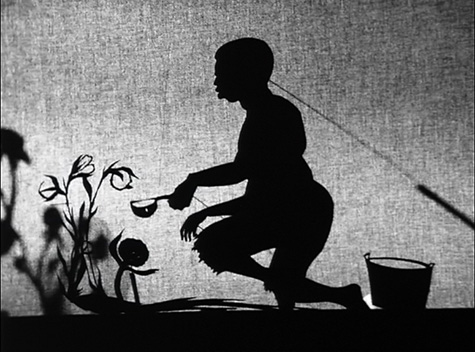
POSING IMPORTANT QUESTIONS Film still from 8 Possible Beginnings or: The Creation of African-America, a Moving Picture by Kara E. Walker, 2005. |
The beauty of Kara Walker's silhouettes lies in their concurrent brutality and daintiness, and in her unabashed exploration cutting to the meat of the black-and-white binary in American contemporary culture. Her stark tableaux offer a thorn to the rose of optimism about race relations today, stripping back social constructs of the last 150 years and provocatively forcing an inquiry into the viewer's visceral perceptions of and reactions to race and power dynamics, and asking what is truly remembered, forgotten, or ignored.
The Bowdoin College Museum of Art is housing Walker's 2005 animated film, 8 Possible Beginnings or: The Creation of African-America, a Moving Picture by Kara E. Walker, in a sequestered dark gallery, perhaps a relief to viewers not expecting the explicitly sexual and violent imagery. Though the subject matter and content are serious, if not controversial, Walker slathers her work in humor and energy, and it is often pretty; its attractiveness further perverts the experience of the work. The emotional response is both a relief and an assault.
Walker, a recipient of the MacArthur Foundation's "genius" grant and a graduate of the Rhode Island School of Design, is best known for her black cut-paper silhouettes addressing themes of power, race, history, gender, and sexuality. Appropriating the 18th-century aristocratic portraiture technique to simultaneously exaggerate stereotyped features and eliminate differences in the skin color of her figures, Walker has harnessed and recast a familiar and nostalgic aesthetic.
8 Possible Beginnings is an eerie episodic burlesque imagining a fantastical origin of slavery in America. The film is black and white and grainy, its vintage quality highlighted by a lack of audible dialogue — intertitles in an old typewriter font sloppily replace conversation and announce the eight chapter titles. The artist is very present throughout the film, her hands manipulating the cut-paper figures; the wires and sticks directing the puppets are also shamelessly visible.
The film opens with a grand soundtrack, harkening to early Disney films, which are later directly referenced, and quickly fades to a harsh silence. A narrative then unfolds in which eight "Authentic Black African Negroes" are dumped from a ship, their rigid cut forms floating in a choppy drawing of sea. An island in the distance, "Motherland!", turns out to be the monstrous head of a woman that swallows the men. They travel through her intestines to be defecated onto new land in the form of one brawny man, who becomes "King Cotton." Textured ambient sound turns into minstrel songs here, and to this soundtrack the strapping man seduces a plantation owner; following an explicit sexual interlude, the scrawny white man impregnates the larger fellow, who after a painful birthing scene, produces a cotton plant.
In the sixth scene, titled "A Darkey Hymn: All I Want," a young black girl slowly walking through a dark forest is closely followed by a menacing plantation owner. The vignette is layered with two female voices, one older and one younger (Walker's daughter) muttering self-deprecating "hopes and prayers" including "I wish I were white," and "I guess this is how it always is, go with the flow." The final scene of the 16-minute film is inspired by Disney's 1946 Song of the South, but in this version, Uncle Remus tells a horrific alternate version of Br'er Rabbit, which concludes with a boy joyfully running past a tree bearing strange fruit.